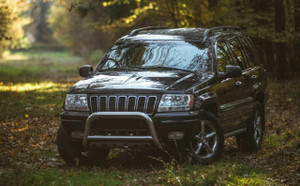SUV buyer's guide
By Kijiji Autos
Sports Utility Vehicles, commonly known as SUVs, are a fantastic way to travel.
They combine the cargo room and seating capacity of a station wagon or MPV (multi-purpose vehicle) with the ground clearance and towing ability of a pickup truck. Sport Utility Vehicles come in all shapes and sizes, so there’s lots to consider when buying one.
What Is an SUV?
An SUV is essentially a wagon that can go off road and tow heavy loads. They’re often based on the underpinnings from a truck, which means you can get either rear-wheel drive (RWD) or 4-wheel drive (4WD). Most use body-on-frame construction (the body is bolted to a full-length ladder frame). By contrast, a crossover vehicle (CUV) is usually based on a front-wheel drive (FWD) car chassis. Thus SUVs give up some off-road and towing capabilities to receive a more car-like ride and handling.
How Big?
These days, you can find everything from a mammoth 9-seat Chevrolet Suburban to the (considerably smaller) Jeep Wrangler. Full-size SUVs offer loads of room for people and stuff, but they’re not very easy to park or maneuver through traffic. Most of them can be ordered with driver aides like blind spot warning systems and cameras to help when backing up. You’ll definitely want to get those features if you plan to drive around in something that’s bigger than your first apartment.
Smaller SUVs also can be challenging to drive, thanks to their tiny windows and huge pillars (the body parts on the corners of the interior that hold up the roof and surround the windows). Nonetheless, they still are easier to thread through traffic than a ‘BargeUV’. The smaller footprint of the smaller SUVs also makes them easier to place off road and control in the snow. Better fuel economy is another advantage of their reduced mass, but you’ll need to make sure that a small-midsize SUV will be able to meet your needs.
2-Wheel Drive or 4-Wheel Drive?
The advantage of driving a truck-based SUV is its off road capability. Thanks to their stiffened platform (the aforementioned truck-like ladder frame), the wheels and axles are able to maneuver over serious obstacles. Real transfer cases (basically the part that transfers power from the engine to the wheels) can also be used to deliver low range, crawl-through-anything torque. The ground clearance typically is much better than that of smaller SUV or car-based CUV.
Depending on where you live, the number of driven axles can be very important. By dividing the engine’s torque between both front and rear axles, a 4WD system can keep your SUV moving forward in deep snow or on muddy tracks. A true 4-wheel drive system uses a transfer case to provide maximum torque in low-speed crawling situations. This allows your SUV to claw its way through deep muck or up steep inclines. On the other hand, an all-wheel drive (AWD) system can only engage the front axle when slippage at the drive axle is detected. This isn’t ideal for serious off-roading, but AWD will certainly help you get the kids to school on a snowy day.
With 2WD or RWD, only one axle receives power from the engine. When wheel slippage occurs, the traction control (or stability control) system will attempt to intervene. However, those systems can only help you to maintain the amount of traction that’s currently available. Whether you choose 4WD, AWD, 2WD or RWD will depend on your needs. If you routinely encounter situations or whether that requires additional traction, you may want to consider an SUV equipped with either AWD or 4WD.
Conclusion
With such a vast array of options available, it’s important to decide what you actually need your SUV to do. Whether you need a truck that can carry you deep into the Yukon, or just a family truckster that can pull a boat and get the kids to school on time, there’s an SUV out there for you. If before you buy you decide on the features that are most important to you, you’ll know what kind of SUV to look for on Kijiji Autos.
Easily find your next ride on Kijiji Autos
Search nowThe most affordable electric cars in Canada in 2023
Looking for a budget-friendly electric car? Discover the 12 most affordable electric cars for sale in Canada on Kijiji Autos. Plus, we answer your FAQs about the costs of driving, charging and insuring an electric car.2023 Mazda 3 GX vs GS: What’s The Difference?
The 2023 Mazda 3 is a refined compact car with styling and performance that give it a upmarket feel. In this article we'll break down the differences between the Mazda 3's GS and GX trim packages to help you decide which features you'd want to take or leave, as well as what they'd cost you. Click on the listings on our Search Results page to discover the Mazda 3 GX and GS for sale near you.FWD vs AWD: What’s the Difference & What’s Right For You?
The main difference between FWD and AWD vehicles is the number of wheels their engines are able to send power to. This article will tell you everything you need to know about FWD vs. AWD and help you decide which is right for you.Coupe vs Sedan: What’s The Difference?
Coupes and sedans can both provide you with practical, fuel efficient transport that can also be fun to drive. Both body styles have their advantages and drawbacks depending on what you’re looking for in a new vehicle. In this article we’ll examine the differences between coupes and sedans and define both vehicles with examples.Is it hard to drive an SUV?
if you're stopping yourself from buying an SUV because you're afraid it's more difficult to maneuver, you'll be pleased to know that's not the case. In fact, first-time drivers will find driving an SUV no more challenging than smaller vehicles like sedans, as long as they follow a few tips outlined below.Top 11 SUVs for Winter Driving in Canada
SUVs are some of the best-suited vehicles for winter conditions with a wealth of standard and available features to help you stay in control and get where you're going when the temperature plummets below zero. Here are 11 of the top SUVs for winter driving.Sedan vs SUV: Which one is right for you?
Sedans and SUVs are two of the most popular kinds of vehicle on the market today. This article will examine the different characteristics of sedans and SUVs, highlighting the areas in which each shines and where their shortcomings lie to help you make the right choice on your next vehicle.Your Guide to Hatchback Cars in Canada
Hatchback cars are defined by their tailgate, which raises up to give access to the rear cargo area. Hatchbacks can feature two or four doors plus the tailgate, and follow what's known as a two-box design. The engine compartment at the front of the car makes up one box, with the second comprising the passenger cabin and cargo area.10 affordable convertible cars in Canada
It may be cliché, but there honestly is nothing like feeling the wind in your hair as you cruise down the highway in a convertible with the top down. Here, we explore 10 affordable convertible cars (in no particular order) to inspire you to dive into Kijiji Autos' listings and find your next vehicle.10 popular full size vans for your family or business
Whether you need to transport people or goods, a large van can be a practical choice. You might be wondering who makes full size vans or what is the best full size for family. Here are 10 of the top big vans for sale in Canada in 2022, in no particular order:









